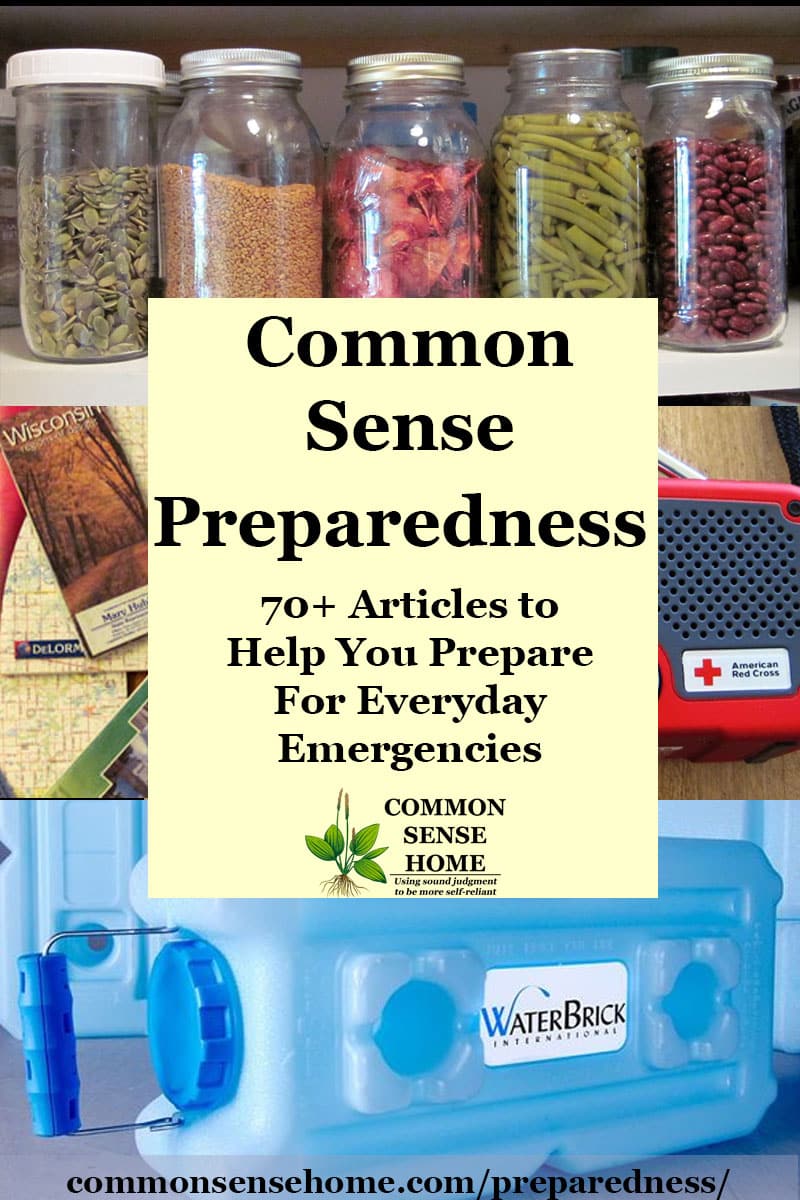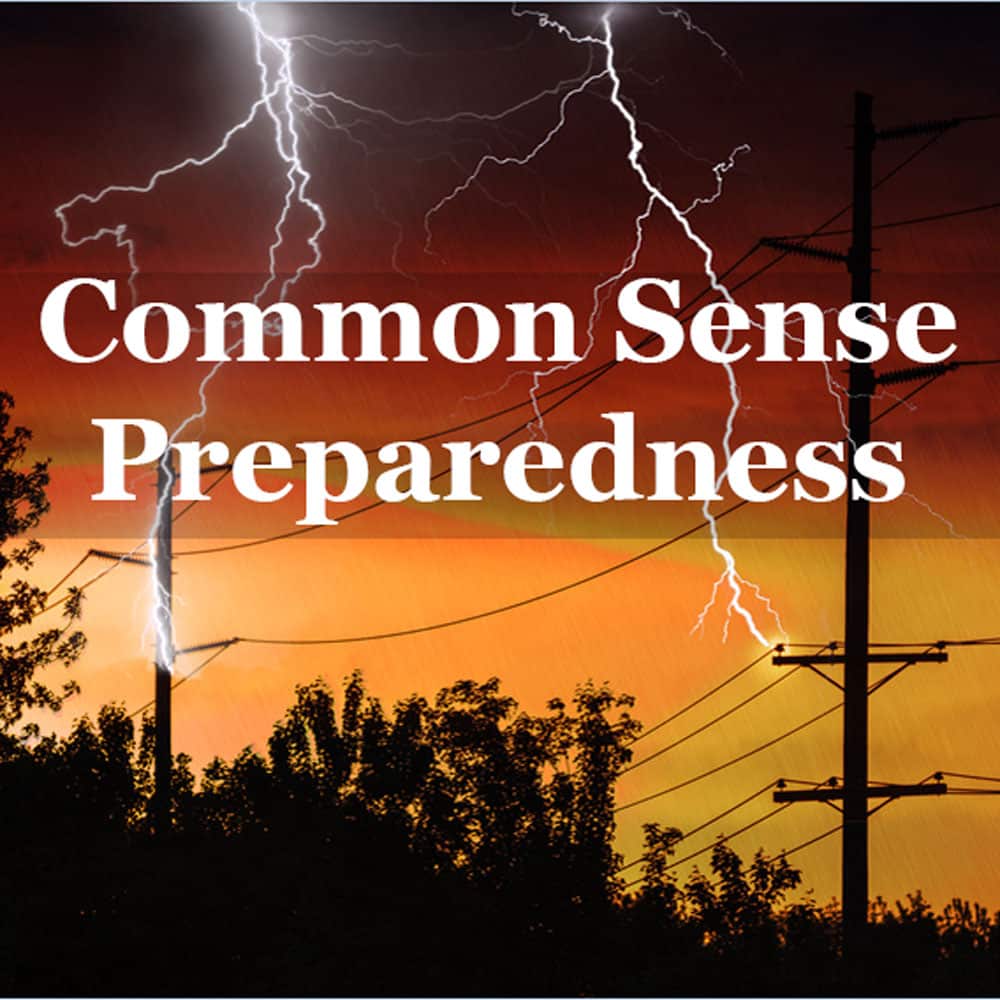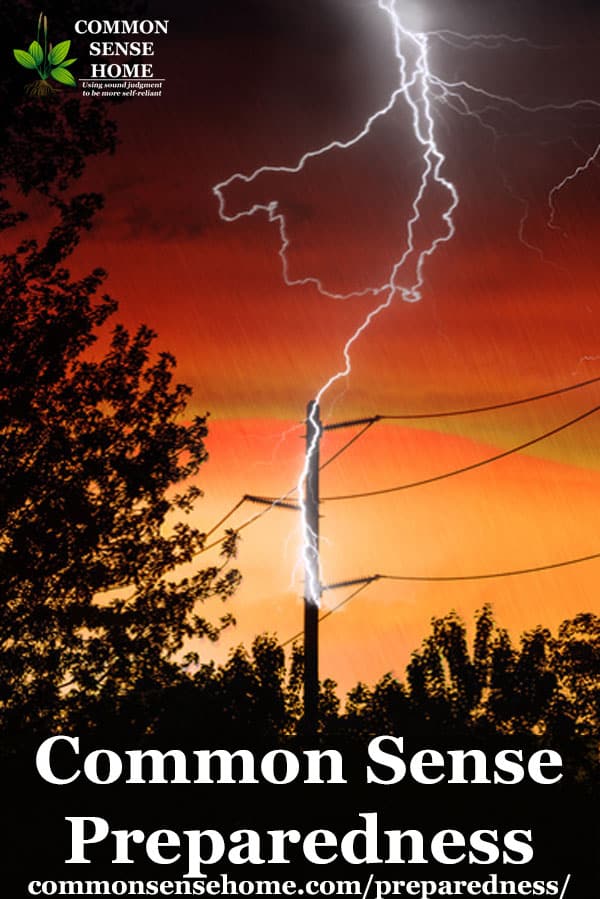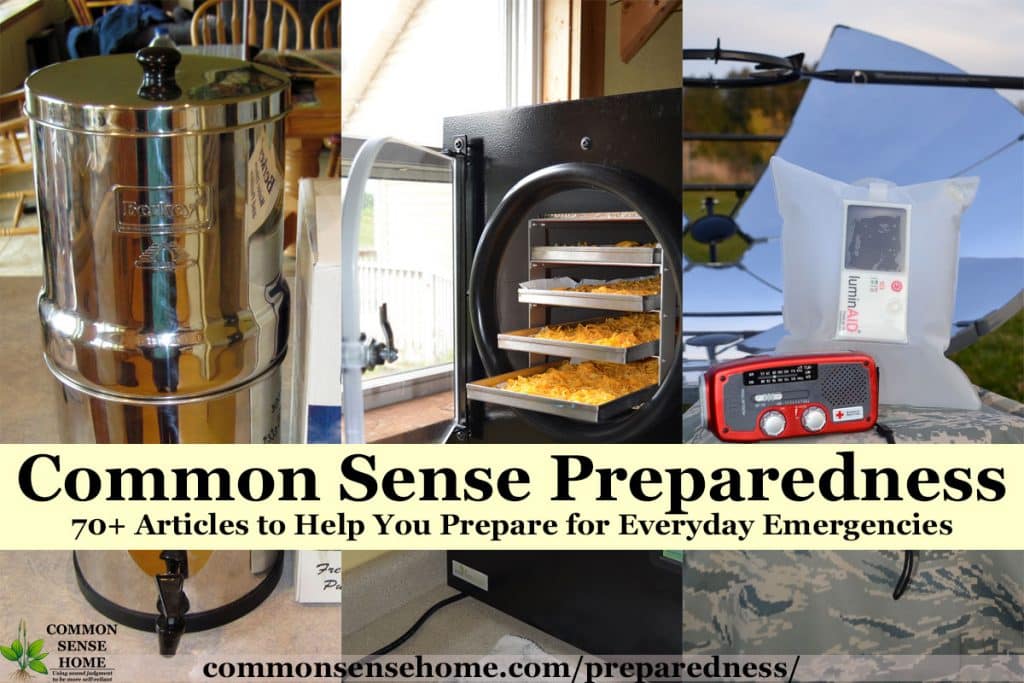Common Sense Preparedness – Preparing for Everyday Emergencies
“Preparedness” means “readiness”. Each day we are faced with challenges – weather conditions, injuries, power outages, water contamination, job loss – you never know what life will bring.
If you have skills and materials on hand to deal with these challenges, things tend to go more smoothly.
Your preps don’t need to be elaborate like those “doomsday” shows. The best options are those that you incorporate into your daily life, not things you stick on a shelf and never use.

These articles will help you prepare for everyday emergencies – food and water, emergency power, cold weather, health, first aid and more.
Cold Weather Preparedness
I’ve lived in one part of Wisconsin or another for all of my life, so I know snow and cold weather. The worst snowfall I was caught in was the Halloween Blizzard of 1991 up in Superior. We received just under 3 feet of snow over Halloween weekend, and the drifts were up to 10 feet deep.
We had some Big Snow years when I was a little girl, too, and the winter of 2013-2014 was one of record cold and snow.
Our Cold Weather Preparedness posts on the site hit key areas – keeping you warm, your vehicle functional, the house warm and the driveway clear.
4 Layers of Cold Weather Clothing Everyone Should Know
Winter Car Kit and Winter Vehicle Maintenance Checklist
Car Won’t Start in the Cold? Check Out these Troubleshooting Tips
Keeping Warm – Winter Prep List for You and Your Home
25 Cheap Ways to Keep Your House Warm in Winter
Best Ways to Keep Your House Warm – New Construction and Remodeling Tips
5 Things You Need to Know Before You Buy a Wood Burning Stove
Emergency Heat During a Power Outage and other Winter Storm Preps
Battery Powered Heater for Emergency Heat? Probably Not
Prevent Frozen Pipes – Extreme Cold Options, Plus Construction Tips
Thawing Frozen Pipes – 3 Ways to Safely Thaw Out Frozen Pipes
Preparedness – Water
Water is life. The general rule of thumb is 3 hours without shelter, 3 days without water and 3 weeks without food – but in reality, it depends on conditions. Individuals have survived 8-10 days without water, but those cases are rare.
Water storage and filtration isn’t just for extreme emergencies, either. It’s rare now that a day goes by where we don’t have news about another water supply getting contaminated.
Get your water tested and get a filtration option in place, if needed, for daily use, and have a filtration option available for emergencies.
Emergency Water Storage and Filtration – What You Need to Know Before Emergencies Hit
3 Emergency Water Filtration Options to Get the Funky Chunks Out
Boil Water Advisory – Safety and Water Use Tips
Rainwater Harvesting Guide – Rain Barrels, Maintenance and More
Preparedness – Food
Stressful conditions such as exposure or exertion burn extra calories, so a good meal can go a long way to improve moral and function.
During World War II, my grandparents (and mother and uncles) ate well because they had a farm and could raise most of their own food. When my husband lost his job, I knew we would still have plenty to eat because we keep a well stocked pantry and root cellar.
I have yet to see any significant, sustained downward trend for food prices, so I consider our food storage an investment against rising food prices.
Freeze Drying
Home Freeze Drying – The Good, The Bad and The Ugly
v8 Best Freeze Dried Foods – Long Term Quality Food Storage
11 Freeze Drying Mistakes to Avoid for Best Storage Quality
Harvest Right Freeze Dryer – Cost Analysis and Optimizing Load Size
Food Storage and Prep
Best Non Perishable Foods (For Home Use or Donations)
Foods to Stock Up On (for Daily Use or Emergencies)
Long Shelf Life Foods – What Lasts the Best?
Valley Food Storage Review (Read Before You Buy)
Backpacker’s Pantry Review – Freeze Dried and Dehydrated Meals
Best Mylar Bags for Food Storage
Top 10 Real Foods to Store Without Electricity
23 Common Sense Ways to Stretch Your Food Budget
Root Cellars 101 – Root Cellar Design and Use – Optimal Storage Conditions for Over 30 Fruits and Vegetables That Store Without Processing
Above Ground Root Cellars – Options for Warm and Cold Climates to Enjoy Local Produce Year Round
Preparedness Storage – Finding Room and Keeping it Safe and Sound
Bulk Grain – Where to Buy It, How to Store It
How to Store Rice Long Term (Over 20 Years!)
How to Store Potatoes Long Term
Emergency Cooking
Emergency Cooking – 10 Ways to Have a Hot Meal When the Power Goes Out
Best Lighter for Emergencies and Every Day Use
Ecozoom Rocket Stove Review – Portable Cooking with Multiple Fuels
Solar Cooking -DIY Solar Cooker Ideas, Printable Cooking Guide
What’s the Best Solar Cooker? Choosing the Right Unit for Your Cooking Style
Unconventional Emergency Food
Eating Bugs – Free Food from Your Backyard
Be sure to check out the Homesteading page for basics on self-reliance, gardening, food preserving, raising animals and more.

Preparedness – Power and Light
While water, food and shelter are primary, it’s tough to get many things done without power and light. Our electric grid is aging, and is vulnerable to acts of nature and cyber attacks. Frankly, I’m surprised we don’t have more brownouts and blackouts than we do.
Whether you’re hit with a power outage, getting in some camping or stuck by the side of the road with a flat, we have posts that cover a number of options for emergency power and light.
When the Power Grid Fails – 10 Things You Need to Prepare
Emergency Power Options for Your Home
Electromagnetic Pulse (EMP) – What You Need to Know
How to Reduce Your Electric Bill (Small Changes Add Up)
LuminAID Solar Powered Lights – Compact, Waterproof & Long Lasting
Solar Emergency Gear – Lights, Power, Radios, and Ovens
Flashlights
The Best Cheap Flashlight – “Best of the Best” Cheap Flashlights List
Brightest Flashlight – AAA, AA, Tactical, Keychain and Spotlight
Alternatives for the aTactical A1S 1150 Lumen Flashlight
Thrunite TN12 Flashlight Review and Usage Tips
Nitecore TINI2 Flashlight Review and Specifications
Batteries and Chargers
Best Battery Chargers and Batteries, Including Portable Battery Chargers
Everything You Need to Know About the 18650 Battery
Everything You Need to Know About the 21700 Battery
The Best AA Batteries for Flashlights, Toys, and More
Nitecore UMS4 Battery Charger Review
Preparedness – First Aid and Hygiene
Keep a well stocked first aid kit and learn how to use pantry and garden items for wound care. The more you know about how to handle basic emergencies, the easier it will be for you to help when disaster strikes.
Many organizations offer training at low or no cost, so keep an eye out for those opportunities.
Best First Aid Kit Recommendations for Home, Car, Office and Travel
Emergency Medical Kit List – Build Your Own Custom First Aid Kit
Surviveware Large First Aid Kit Review – Pros and Cons
Best Camping Shower Bags Comparison, Plus Outdoor Shower Tips
Heat Stroke – Symptoms, Treatment and Prevention
Honey as Medicine – Prevent Infection, Kill Bacteria, Promote Healing
11 Best Medicinal Herbs to Grow (Herb Garden & Wildcrafted)
Storage and Shelf Life of Over the Counter Medication
Protect Yourself from Salmonella and E Coli Naturally
DIY Portable Toilet, Plus Tips to Get Rid of Smells
How to Build a Burn Barrel – Burn Trash Safely
What is The Plague, How Could I Get It and How Dangerous is It?

Storm Preparedness
Many of the other posts do apply during storm warnings, but these are specifically storm focused.
Before the Hurricane – The Common Sense Hurricane Guide Series (Part 1 of 3)
During the Hurricane – The Common Sense Hurricane Guide Series (Part 2 of 3)
After the Hurricane – The Common Sense Hurricane Guide Series (Part 3 of 3)
What to Get Ready for a Hurricane – Printable Hurricane Prep Checklist
Preparedness – Summer Storms, Tornadoes and Hurricanes
20 Things I Wish I Had Before the Flood from a “1000 Year Storm” Survivor
Safe Rooms – How to Create a Stormproof Room in Your Home – Plus Possible Funding Sources
General Preparedness
Whether you shelter in place or need to evacuate when trouble strikes, having a plan can help you get through whatever life throws at you. How likely is an emergency? Check out the odds below.
Where do you get started and how can you make preparedness a part of your lifestyle? See how our grandparents made common sense choices to take care of their families. Plan, don’t panic.
Everyday Emergencies
Emergency Radios (Receive Only and Handheld Transceiver Radios)
BAOFENG BF F8HP – Review and Recommended Accessories
Grandma and Grandpa Were Preppers
Preparedness Basics – 5 Simple Steps to Start Today
Bugging Out/ Evacuation
Roadside Emergency Kit Recommendations and Checklist
Bug Out Bag or “Get Home Bag” DIY Checklist
Radiation
Emergency Preparedness – Radiation Exposure

Cold and Flu Remedies
The CDC states that, “The annual direct costs, such as hospital and doctor’s office visits, medications, of influenza (flu) in the United States are an estimated $4.6 billion. The flu causes U.S. workers to lose up to 111 million workdays at an estimated $7 billion a year in sick days and lost productivity.”
There’s no magic cure for the flu or common cold, but there are steps you can take to reduce your risk of transmission and duration of symptoms.
Natural Remedies for Colds and Flu to Help You Feel Better Faster – summary of all our cold and flu related posts
Flu Prevention and Treatment – 10 Quick Tips, Old and New
Thieves Vinegar – Immune Booster and Germ Killer
Probiotics for Colds and Flu – Fewer Symptoms, Faster Recovery Time
Knock Out Cold and Flu Germs with Essential Oils
The Best Supplements to Prevent and Treat Cold and Flu
Best Cold Remedies – Herbs and Spices – Plus a Secret Weapon
The Best Home Remedies for Stomach Flu Treatment
Make Homemade Elderberry Cough Syrup with Juice or Dried Berries
Easy Homemade Cough Drops for Treatment of Sore Throats and Coughs
Immune Boosting Herbs in Finger Gelatin
Cold and Cough Care from Mountain Rose Herbs
See also treatments for coughs, congestion, earaches and sore throat.
Wildcrafting and Herbs
Many common weeds have a long history of use for food and medicine. If you’d like to learn more, visit the Herbs and Wildcrafting page.
What’s Missing?
The world’s a big place with a lot going on. Leave a comment with your request for preparedness topics that you want covered on the site, and don’t forget to Pin or bookmark this index.
Originally posted in 2012, last updated in 2018.

Laurie, I want to leave this link here for you. I bought this book last year but when I was getting the link for you I saw that it’s available on PDF, for free!
Very very valuable guide. “Where There Is No Doctor”
We have the freeze dryer with the oil free pump and have been using it for a bout 6 months. The pump is kind of loud so my husband made a metal box around the front, top, bottom and 3 sides) with 2-3 inches of clearance for air flow in order to try to muffle the sound.The back is entirely open. I have noticed that the grey base of the pump gets pretty hot during operation. I am concerned that perhaps the enclosure could be restricting some of the ability for heat to dissipate. There is about 6 inches from the back of the pump that is entirely open to the wall and it seems that the heat is escaping alright. I am just concerned about the hotness of the pump possibly shortening its lifespan. Do you know how hot the oil free pumps normally get when operating? We could always remove the box and run it again to see if it still gets as hot. Honestly did not check that in the beginning as the noise being disruptive at night was more the issue. The unit is in the basement as far away from the bedroom as we could get to minimize the noise.
I don’t have the oil free pump, just the standard pump, but that gets pretty hot. I think your concerns about the box shortening the lifespan of the pump are valid. When the temperature in the garage (where we have our unit) gets near the maximum operating temperature, I put a stand fan near my pump to help keep it from overheating.
Have you ever freeze dried butternut squash? I am wondering if it can be freeze dried raw in cubes or if it should be cooked first. It sounds like it can be frozen raw so I wondered if could be freeze dried the same way. In general would you recommend blanching even for non-cruciferous vegetables? I did some green beans raw as I saw they can also be frozen without blanching. They seemed to turn out OK. I have not tried rehydrating them yet but presume would need to simmer before would be ready to eat. Appreciate your advice on that.
You can sample the beans without rehydrating.
When we did winter squash, I cooked it and made puree, since that’s what I use the most.
I checked the freeze dryer groups that I am in on Facebook, and a user posted this:
She did the raw squash in chunks, and the roasted looks like it was cooked in halves and then scraped out of the shell.
i don’t have a post, i want to subscribe, this is the only space where i can to leave my email… looks like your subscription link is missing
The forms don’t display in every browser. We try to get them to show up, but with all the different ways people access the web and different blocking software, it doesn’t always work.
I’ve submitted your email and you should be getting a an email shortly to confirm your subscription.
I enjoyed your article about freeze drying. Would consider it if you could answer several questions. Has anyone ever put food in a mason jar with no lid and freeze dried it in the jar. That way all you have to do is put in the oxygen absorber and seal the jar. Some vacuum sealer have an attachment for jars. Another question I have is, since like most country people, I hunt and freeze my game. Can I take meat that is already frozen and finish the freeze drying process. Have a lot of game already frozen and really do not want it to freezer burn. Any suggestions.
It would not be a good option to attempt to freeze dry inside a jar. During the freeze drying process, water in the food goes from ice directly to vapor (sublimates). In the Harvest Right freeze dryers, this vapor then deposits on the outside of the chamber (away from the food) and forms a layer of ice when it freezes again as the dryer cycles. Inside a jar, even with the top open, sublimation would be greatly inhibited.
Meat and other foods that are already frozen may be freeze dried. They should still be allowed to freeze in the freeze dryer, because it gets them much colder than a standard freezer. Surface area should also be maximized to increase efficiency of drying and avoid damp spots deep within a thick pile of food. The freeze drying process will not cause freezer burn, but if you attempt to put a big block of frozen food in to freeze dry, it’s likely to stay damp in the middle.
Thank you for the article on radiation treatments. With the tensions between nations and the recent false alarm in Hawaii, it gives us more items to keep on hand and preps for our emergency supplies and bug out bags too. Thank you for putting so much thought into helping others prepare for any emergency.
You’re welcome. There’s a ton of information on the internet, but far too much of it is also served up with fearmongering, which does no one any good, or is poorly researched. When bad things happen, as they always do, we need folks with level heads and a plan in place.
I so enjoy this web site. I’ve thought of a couple of things for a B.O.B. A small wood burning cook stove like my Solo Lite might be useful. I also wonder if perhaps 1-2 traps although heavy might work. For instance a # 1 victor or similar. If a person is anywhere near water it is very easy to trap muskrats. I know it might not be very appealing to some but the meat is really quite good. The fur could either be sold to a fur buyer or used for various items to keep you warm. In most areas it should be very easy to trap enough to eat.
I have used the Solo Lite stove on many canoe trips and it sure is nice to not have to haul fuel out there. It provides a roaring fire which gasifies the wood which makes for a very efficient fire.
Everyone here has some great ideas which makes it fun!
Glad you enjoy the site, Jerry. I haven’t eaten muskrat, but since they are plant eaters, I would think that they would be fairly tasty. The Biolite stoves might be another handy option as a camp stove, since they are similar in size to the Solo, but also feature a built in charger so people can charge their phone with their campfire.
Thanks for sharing your experience.
Lot’s of learning here! New homestead. UKULELE ATLANTA HOLLY
Awesome list!
I’m guessing you’re updating this as you’re writing them, right? I was thinking something about survival skills would fit in nicely.
Thanks,
Dan
Would love to get e-mails from this site. How do I sign up for it?
Dale, there’s a box on the sidebar or visit – https://commonsensehome.com/subscribe/
Kudos on your content. Lot of good information in there. I am a former legal secretary and crazy proofreader. I hope you don’t think I’m too critical, but in your page title “judgement” is really spelled “judgment.”
Nancy – no worries. I know I make plenty of mistakes, but hopefully still manage to get the point across most of the time. 🙂 Both “judgement” and “judgment” are still in use, although you are correct the lack of “e” version is more commonly used currently in the US: http://www.dailywritingtips.com/judgement-or-judgment/
You are awesome! What a GREAT list of preparedness ideas and must haves. I hope you like your Bekey. I hug mine every morning. Ok, I don’t but it is TE best investment I have ever made. My mom told me I wasted my $$ and she LOVES it. My sis in NC is even thinking of getting one. Enjoy.
lol – I just pictured you hugging a big silver container. 🙂 We have an RO system installed, so the Big Berkley is mostly back up, but my son loves the Sport Berkley. I wanted to have a practical way to filter our rain water in case of emergency, since we still don’t have an emergency hand pump for our well (but we do have a generator which can power the regular pump).
Thanks for the pep talk!
Oh wow, Laurie, what a GREAT list of resources! I just posted yesterday about preparedness and so your pulling together of this information is so very timely! Awesome!
Thanks, Kristi! I’ve got to pull a post together on water next. Soon! Must tinker with the Berkley.
Great! Looking forward to seeing it! 🙂